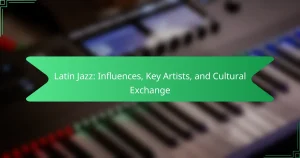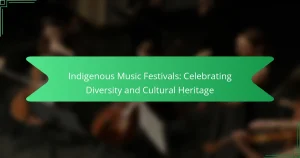Bhangra offers significant health and social benefits while fostering cultural pride and community connection. This article explores its traditional roots, modern interpretations influenced by global music trends, and the challenges it faces in preserving authenticity. We will also discuss the diverse forms of Bhangra found in regions like Punjab, Canada, and the UK, highlighting its adaptability and global reach.
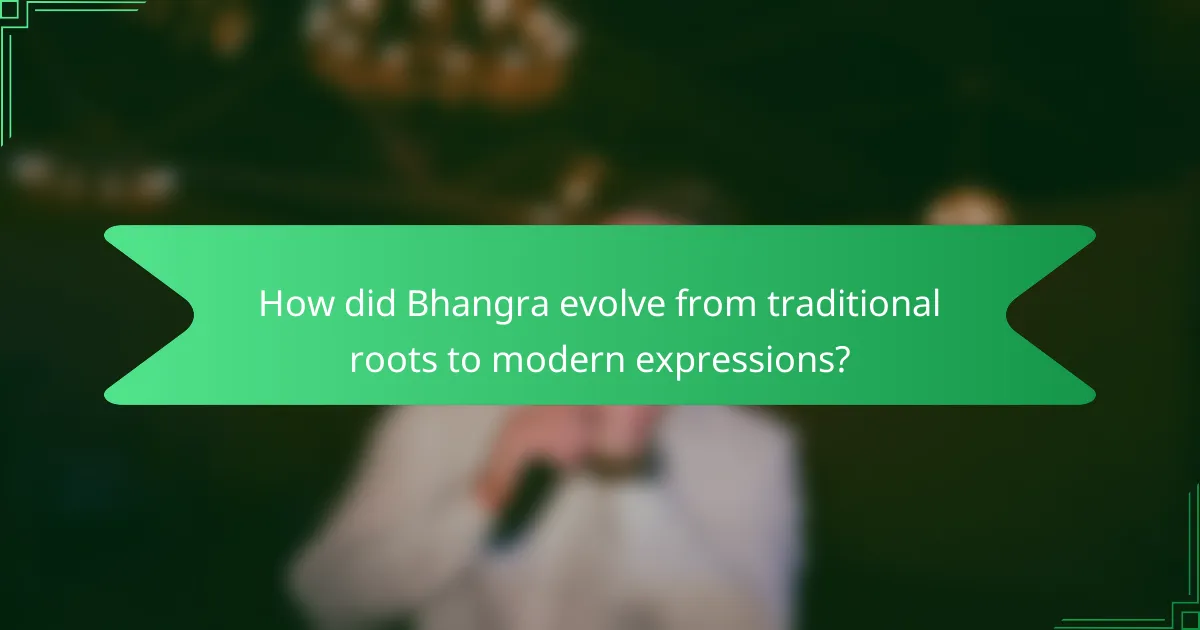
How did Bhangra evolve from traditional roots to modern expressions?
Bhangra evolved from traditional roots into a modern expression through cultural fusion and globalization. Initially a folk dance from Punjab, it incorporated influences from various music genres, including hip-hop and electronic dance music. This transformation broadened its appeal, leading to global recognition and participation in mainstream events. The unique attribute of Bhangra is its adaptability, allowing it to merge with different styles while retaining its vibrant energy and rhythm. Today, Bhangra is celebrated worldwide, showcasing its rich heritage and contemporary interpretations.
What are the key elements of traditional Bhangra music and dance?
Bhangra music and dance feature vibrant rhythms, energetic movements, and traditional instruments. Key elements include the dhol drum, which provides a lively beat, and lively choreography that often incorporates group formations. The dance is characterized by its expressive arm and leg movements, reflecting joy and celebration. Unique attributes include the regional variations in style and music, which enhance its global appeal.
How have contemporary artists reinterpreted Bhangra?
Contemporary artists have reinterpreted Bhangra by blending traditional elements with modern genres like hip-hop and electronic music. This fusion expands Bhangra’s global reach and introduces new audiences to its vibrant rhythms and dance styles. Artists such as Panjabi MC and DJ Rekha have played pivotal roles in this transformation, incorporating innovative beats and lyrics while maintaining cultural authenticity. The result is a dynamic evolution of Bhangra that resonates with both traditionalists and modern music enthusiasts.
Which cultural influences have shaped modern Bhangra styles?
Modern Bhangra styles have been shaped by diverse cultural influences, including Punjabi folk traditions, hip-hop, and global dance genres. The fusion of traditional rhythms with contemporary beats reflects a unique blend of heritage and innovation. Collaboration with artists from various backgrounds has introduced elements from reggae, electronic music, and even Bollywood, enhancing Bhangra’s global appeal. This evolution showcases Bhangra’s adaptability and its role as a vibrant cultural expression that resonates worldwide.
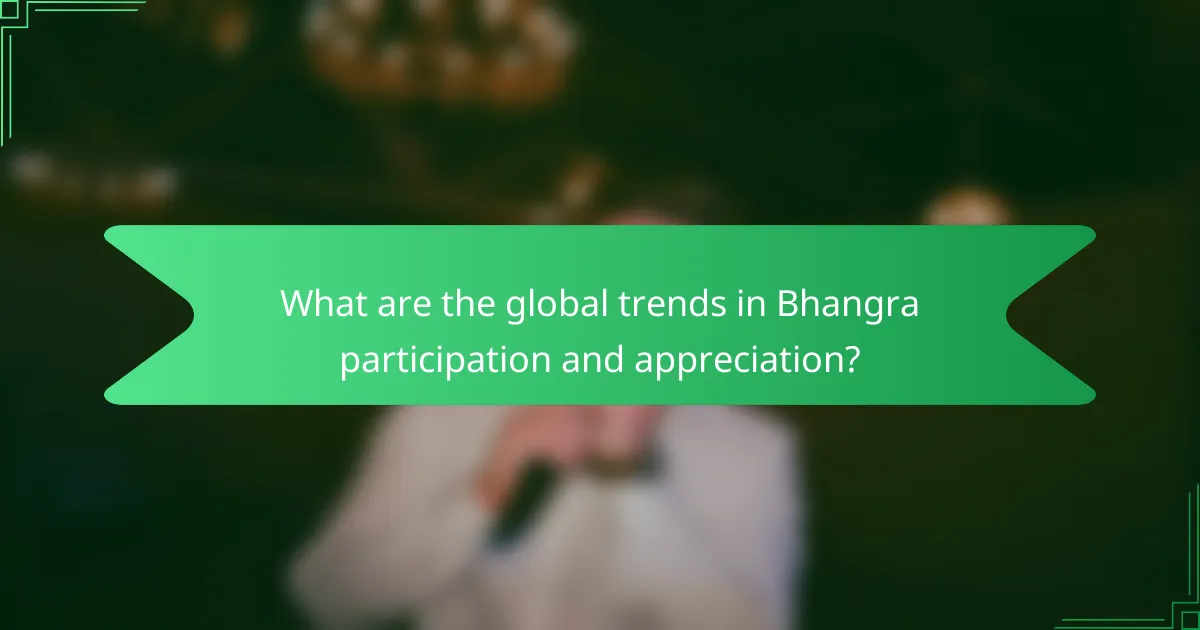
What are the global trends in Bhangra participation and appreciation?
Bhangra participation and appreciation are rising globally, driven by cultural fusion and social media. The genre attracts diverse audiences through festivals, dance classes, and online platforms. In countries like Canada and the UK, Bhangra has become a staple in multicultural celebrations, showcasing its adaptability. Furthermore, collaborations with contemporary artists enhance its reach and relevance, making Bhangra a vibrant part of the global music landscape.
How has Bhangra gained popularity outside of its cultural origins?
Bhangra has gained global popularity through cultural fusion, innovative choreography, and widespread media exposure. Its energetic dance style resonates with diverse audiences, leading to collaborations across genres. Major music festivals and social media platforms amplify its reach, showcasing vibrant performances. The incorporation of Bhangra in popular music further enhances its appeal, making it a staple in celebrations worldwide.
What role do social media and technology play in Bhangra’s global reach?
Social media and technology significantly enhance Bhangra’s global reach by facilitating cross-cultural exchange. Platforms like Instagram and TikTok allow artists to share performances worldwide, attracting diverse audiences. Streaming services promote Bhangra music, making it accessible beyond traditional venues. The use of digital collaboration tools enables artists from different regions to collaborate, blending styles and expanding the genre’s appeal. As a result, Bhangra evolves while retaining its traditional roots, showcasing its adaptability in a modern context.
Which international events showcase Bhangra and its variations?
International events that showcase Bhangra and its variations include cultural festivals, dance competitions, and music festivals. Notable examples are the Bhangra Blowout in the United States, the UK Bhangra Festival, and the Toronto Bhangra Festival. These events celebrate traditional Bhangra while highlighting modern interpretations and global influences. Participants often include local and international dance troupes, showcasing the evolution of this vibrant art form.

What are the health and social benefits of practicing Bhangra?
Practicing Bhangra offers significant health and social benefits. It improves cardiovascular fitness, enhances coordination, and boosts mental well-being through joyful expression. Socially, Bhangra fosters community connection and cultural pride, creating a sense of belonging among participants. As a result, it promotes both physical health and social cohesion, making it a valuable activity in diverse settings.
How does Bhangra contribute to physical fitness and well-being?
Bhangra significantly enhances physical fitness and well-being through its energetic dance movements. Engaging in Bhangra improves cardiovascular health, increases muscle strength, and boosts endurance. The rhythmic nature of the dance promotes coordination and flexibility, contributing to overall body agility. Additionally, Bhangra serves as a social activity, fostering community connections and reducing stress, which positively impacts mental well-being.
What social connections are fostered through Bhangra communities?
Bhangra communities foster strong social connections through shared cultural practices, celebrations, and collective participation. These connections enhance community cohesion and promote cultural identity. Events like Bhangra competitions and festivals encourage collaboration and friendship among participants, transcending geographical boundaries. Additionally, the fusion of traditional and modern elements in Bhangra attracts diverse groups, further strengthening social ties.

Which unique forms of Bhangra are recognized in different regions?
Bhangra has unique forms recognized across various regions, each reflecting local culture. In Punjab, traditional Bhangra emphasizes vibrant dance and music. In the UK, it has evolved into a fusion style, incorporating hip-hop elements. In Canada, community-based Bhangra showcases cultural heritage through festivals. The United States features competitive Bhangra, emphasizing performance and choreography. Each region adds distinctive attributes, enriching the global Bhangra landscape.
What distinguishes Punjabi Bhangra from other regional variations?
Punjabi Bhangra is distinguished by its energetic dance style, vibrant music, and cultural significance rooted in agricultural celebrations. It features lively rhythms, traditional instruments like the dhol, and specific dance moves that reflect the region’s heritage. Unlike other regional variations, Punjabi Bhangra incorporates a unique blend of folk elements and contemporary influences, making it highly adaptable and popular worldwide. The emphasis on community and celebration further sets it apart, creating a distinct identity within the broader Bhangra genre.
How do fusion genres incorporate Bhangra elements?
Fusion genres incorporate Bhangra elements by blending traditional rhythms and instruments with modern styles. This integration enhances the global appeal of Bhangra, allowing it to reach diverse audiences. For example, hip-hop and electronic music often feature Bhangra beats, creating a dynamic sound that resonates across cultures. The unique attribute of Bhangra’s infectious energy makes it a popular choice in various musical fusions, promoting cultural exchange and innovation.
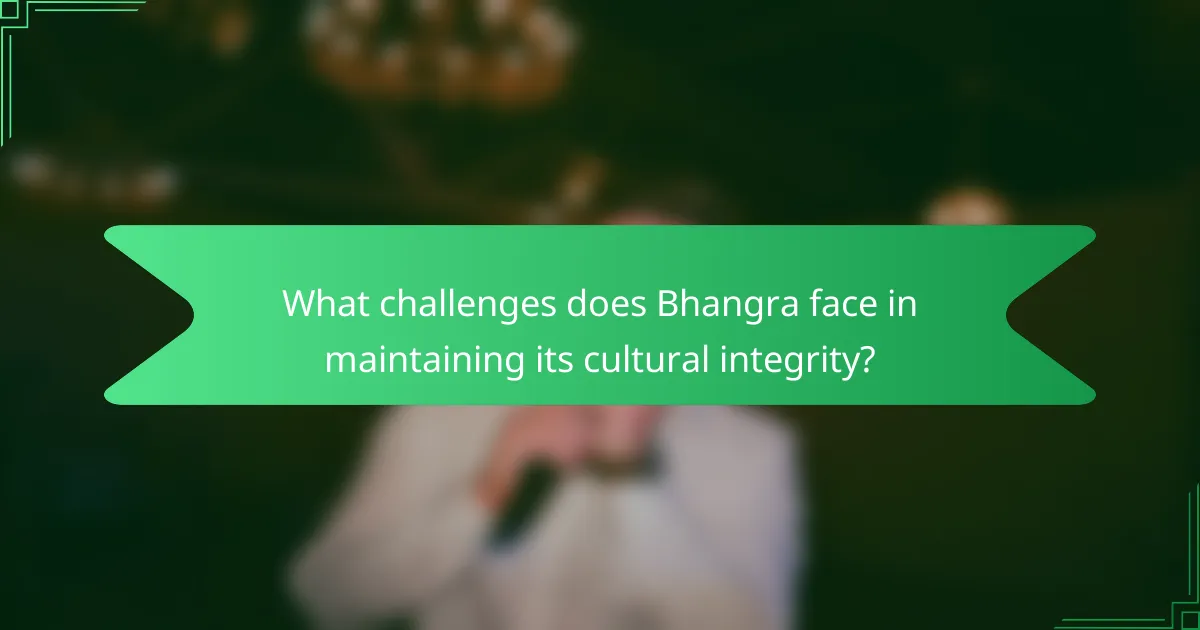
What challenges does Bhangra face in maintaining its cultural integrity?
Bhangra faces challenges in preserving its cultural integrity due to commercialization, cultural appropriation, and dilution of traditional practices. These factors often lead to a disconnect between authentic expressions and modern adaptations. The rise of global fusion styles can overshadow traditional forms, risking the loss of unique attributes vital to Bhangra’s heritage. Additionally, the influence of social media can promote trends that prioritize entertainment over cultural significance, complicating the preservation of its roots.
How do commercialization and globalization impact traditional practices?
Commercialization and globalization significantly transform traditional practices like Bhangra. These forces introduce new audiences, alter original forms, and create hybrid styles.
Bhangra, rooted in Punjab, evolves as it gains popularity worldwide. Commercialization leads to professional performances and music production, enhancing visibility but risking cultural dilution. Globalization fosters cross-cultural collaborations, blending Bhangra with diverse music genres, thus expanding its reach.
The unique attribute of Bhangra’s adaptability allows it to thrive in various contexts. While this evolution can enrich the tradition, it also raises concerns about preserving authentic practices in the face of commercialization and globalization.
What are the concerns regarding cultural appropriation in Bhangra?
Concerns regarding cultural appropriation in Bhangra focus on the commercialization and dilution of its traditional roots. Critics argue that non-Punjabi performers often misrepresent the dance’s cultural significance. This can lead to the loss of authentic expression and disrespect towards its origins. Additionally, the blending of styles may overshadow the original cultural context, causing tension within the community. Ensuring respectful representation is essential to preserving Bhangra’s unique heritage.
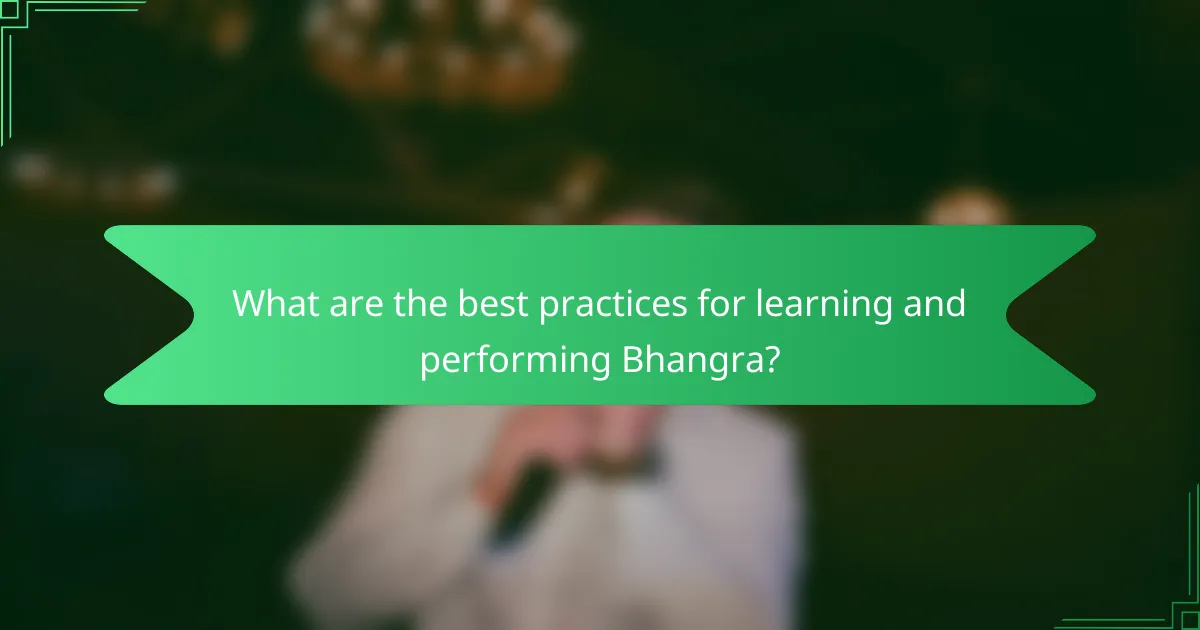
What are the best practices for learning and performing Bhangra?
To learn and perform Bhangra effectively, practice regularly, embrace the cultural roots, and engage with experienced dancers. Focus on mastering the basic steps, rhythm, and expressions that define this vibrant dance form.
Incorporate these best practices:
1. Attend workshops for hands-on experience.
2. Watch instructional videos to understand techniques.
3. Join a local Bhangra group for community support.
4. Perform regularly to build confidence and stage presence.
These strategies enhance skills while preserving the essence of Bhangra, fostering both traditional appreciation and modern creativity.
How can beginners effectively start their Bhangra journey?
Beginners can effectively start their Bhangra journey by focusing on foundational techniques, cultural understanding, and consistent practice. Begin by learning basic steps and rhythms through online tutorials or local classes. Engage with the cultural aspects by attending workshops or community events. Regular practice is essential to build confidence and improve coordination. Consider joining a dance group to enhance skills and connect with others passionate about Bhangra.
What common mistakes should be avoided in Bhangra performances?
To enhance Bhangra performances, avoid common mistakes that can detract from authenticity and audience engagement. Key missteps include neglecting traditional techniques, failing to synchronize with the music, and overlooking audience interaction.
Improper attire can also undermine the visual impact. Additionally, not practicing enough can lead to unpolished routines, while ignoring cultural significance may alienate traditional audiences. Emphasizing these aspects ensures a more vibrant and respectful performance.
Which resources and communities support Bhangra enthusiasts?
Bhangra enthusiasts can find support through various resources and communities worldwide. Online platforms like Facebook groups and forums connect dancers and musicians, fostering collaboration and sharing. Organizations such as the UK Bhangra Awards celebrate talent and promote cultural appreciation. Local dance studios and cultural centers offer classes and workshops, enhancing skills and community engagement. Additionally, festivals and competitions provide opportunities for performance and networking, enriching the global Bhangra scene.

